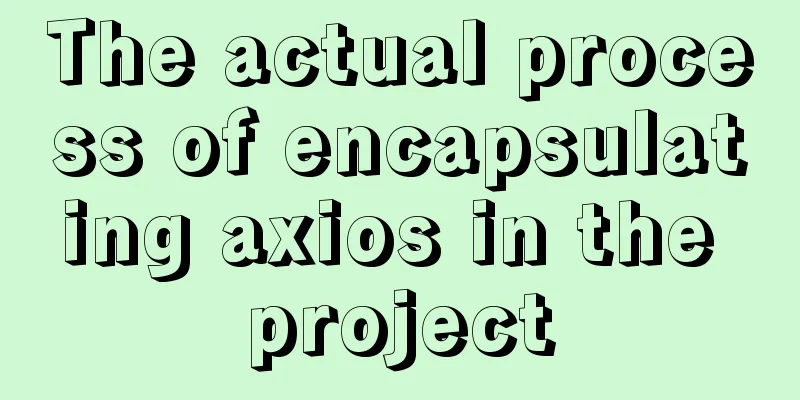JavaScript to achieve elastic navigation effect

|
This article shares the specific code for JavaScript to achieve elastic navigation effects for your reference. The specific content is as follows Mainly using offsetX 1. Build the scaffolding first:
* {
margin: 0;
padding: 0;
}
.nav {
width: 900px;
height: 63px;
background: url(images/doubleOne.png) no-repeat right center;
border: 1px solid #ccc;
margin: 100px auto;
position: relative;
}
ul {
position: relative;
z-index: 999;
}
ul>li {
list-style: none;
float: left;
width: 88px;
height: 63px;
line-height: 63px;
text-align: center;
}
span {
display: inline-block;
width: 88px;
height: 63px;
background: url("images/tMall.png") no-repeat;
position: absolute;
left: 0;
top: 0;
}
<div class="nav">
<ul>
<li>Double 11 Carnival</li>
<li>Clothing venue</li>
<li>Digital home appliances</li>
<li>Home building materials</li>
<li>Mother and baby clothing</li>
<li>Mobile venue</li>
<li>Beauty and makeup venue</li>
<li>Import Venue</li>
<li>Fliggy Travel</li>
</ul>
<span></span>
</div>
2. Write the logic part
//1. Get the element to be operated const oItems = document.querySelectorAll("li");
let oSpan = document.querySelector("span");
//2. Listen for click events of each menu for (let i = 0; i < oItems.length; i++) {
let item = oItems[i];
item.onclick = function() {
//offsetLeft gets the offset of the clicked element from the first positioned ancestor element // console.log(this.offsetLeft);
// oSpan.style.left = this.offsetLeft + 'px';
//Call function easeAnimation(oSpan, {
"left": this.offsetLeft
});
};
}animation.js
(function() {
/**
* Uniform speed animation* @param {*} ele Element to perform animation* @param {*} obj Which attributes of the element need to be animated* @param {*} fn Operations that may need to be performed after the animation is completed*
* Calling method reference* linearAnimation(oDiv, {
"marginTop": 500,
"marginLeft": 300
});
*/
function linearAnimation(ele, obj, fn) {
clearInterval(ele.timerId);
ele.timerId = setInterval(function() {
//The flag variable is used to mark whether all properties have completed the animation. let flag = true;
for (let key in obj) {
let target = obj[key];
// 1. Get the current position of the element // let begin = parseInt(ele.style.width) || 0;
let style = getComputedStyle(ele);
// let begin = parseInt(style.width) || 0;
let begin = parseFloat(style[key]) || 0;
// 2. Define variables to record step length let step = (begin - target) > 0 ? -13 : 13;
// 3. Calculate the new position begin += step;
// console.log(Math.abs(target - begin), Math.abs(step));
if (Math.abs(target - begin) > Math.abs(step)) { //Animation not completed flag = false;
} else { //After executing the animation begin = target;
}
// 4. Reset the element's position // ele.style.width = begin + "px";
ele.style[key] = begin + "px";
}
//Judge whether the animation has been executed if (flag) {
//After the animation is finished, turn off the timer clearInterval(ele.timerId);
//Judge whether the fn function is passed in, execute it if it is passed in, otherwise do not execute it // if (fn) {
// fn();
// }
fn && fn();
}
}, 100);
}
//Easy animation function easeAnimation(ele, obj, fn) {
clearInterval(ele.timerId);
ele.timerId = setInterval(function() {
//The flag variable is used to mark whether all properties have completed the animation. let flag = true;
for (let key in obj) {
let target = obj[key];
// 1. Get the current position of the element let style = getComputedStyle(ele);
let begin = parseInt(style[key]) || 0;
// 2. Define variable record step size // Formula: (end position - start position) * easing coefficient (0 ~ 1)
let step = (target - begin) * 0.3;
// 3. Calculate the new position begin += step;
if (Math.abs(Math.floor(step)) > 1) {
flag = false;
} else {
begin = target;
}
// 4. Reset the element's position ele.style[key] = begin + "px";
}
//Judge whether the animation has been executed if (flag) {
//After the animation is finished, turn off the timer clearInterval(ele.timerId);
//Judge whether the fn function is passed in, and execute it if it is, otherwise do not execute fn && fn();
}
}, 100);
}
// Bind the function to the window object so that it can be used globally window.linearAnimation = linearAnimation;
window.easeAnimation = easeAnimation;
})();
The above is the full content of this article. I hope it will be helpful for everyone’s study. I also hope that everyone will support 123WORDPRESS.COM. You may also be interested in:
|
<<: How to keep the content within the container when the flex layout is stretched by child elements
>>: 9 Tips for Web Page Layout
Recommend
Example of how to implement local fuzzy search function in front-end JavaScript
Table of contents 1. Project Prospects 2. Knowled...
18 common commands in MySQL command line
In daily website maintenance and management, a lo...
Example of creating circular scrolling progress bar animation using CSS3
theme Today I will teach you how to create a circ...
Introduction to the use and advantages and disadvantages of MySQL triggers
Table of contents Preface 1. Trigger Overview 2. ...
Solve the problem that VMware cannot install 64-bit operating system in win10 home version
Problem Description When VMware Workstation creat...
Analyze the duration of TIME_WAIT from the Linux source code
Table of contents 1. Introduction 2. First, let&#...
Detailed steps to install Docker mongoDB 4.2.1 and collect springboot logs
1: Install mongodb in docker Step 1: Install mong...
Detailed explanation of the difference between flex and inline-flex in CSS
inline-flex is the same as inline-block. It is a ...
Vue Page Stack Manager Details
Table of contents 2. Tried methods 2.1 keep-alive...
Learn one minute a day to use Git server to view debug branches and fix them
Debug branch During the normal development of a p...
A brief discussion on VUE uni-app template syntax
1.v-bind (abbreviation:) To use data variables de...
Detailed steps for configuring mysql8.0.20 with binlog2sql and simple backup and recovery
Table of contents First step installation Step 2:...
Apply provide and inject to refresh Vue page method
Table of contents Method 1: Call the function dir...
The table table uses: nth-child() to achieve alternate color change and alignment
Core code <!DOCTYPE html> <html lang=&qu...
Html easily implements rounded rectangle
Question: How to achieve a rounded rectangle usin...











